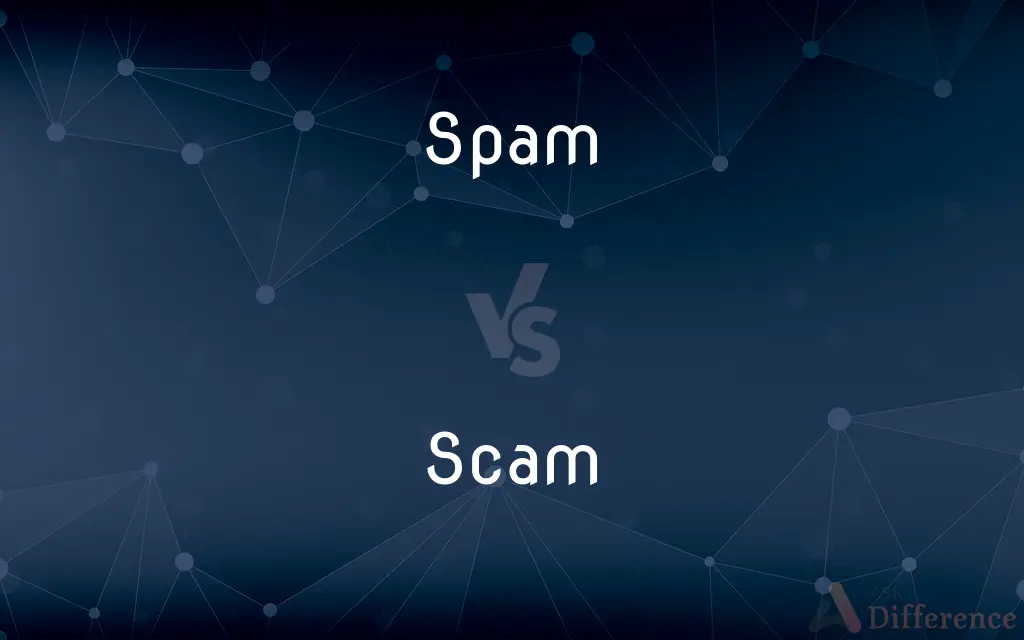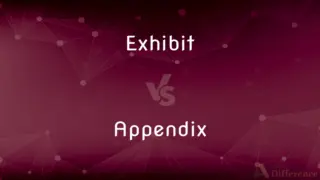Spam vs. Scam — What's the Difference?
Edited by Tayyaba Rehman — By Maham Liaqat — Updated on March 16, 2024
Spam refers to unsolicited, often irrelevant or repetitive messages sent over the internet, mainly for advertising purposes, while scam involves deceptive practices aimed at obtaining money or personal information under false pretenses.

Difference Between Spam and Scam
Table of Contents
ADVERTISEMENT
Key Differences
Spam is characterized by the mass distribution of messages, which can include emails, text messages, and social media posts, without the recipient's consent. These messages are typically aimed at advertising products or services, spreading malware, or simply flooding the recipient with information. On the other hand, a scam is a fraudulent scheme designed to deceive individuals into giving away their money, personal information, or both, often by promising false rewards, threatening, or impersonating legitimate entities.
While spam can be a nuisance, cluttering inboxes and potentially leading to phishing attempts, scams pose a direct threat to an individual's financial security and personal identity. Scams often require a more sophisticated approach than spam, utilizing psychological manipulation and exploiting trust to achieve their goals.
The intent behind spam is usually commercial gain or, in some cases, harm through the dissemination of malware. In contrast, scams are inherently malicious, with the primary aim of stealing from or harming the victim. Although some spam can be part of a scamming effort, not all spam is designed to defraud.
Regulatory measures against spam include laws like the CAN-SPAM Act in the United States, which sets rules for commercial email, establishes requirements for commercial messages, and gives recipients the right to have emails stopped from being sent to them. Scams, being illegal fraudulent activities, are subject to law enforcement actions, and various agencies work to combat scam operations.
Both spam and scams require vigilance and preventive measures from internet users. Recognizing spam involves looking out for unsolicited messages and repetitive content, while identifying scams may require skepticism towards too-good-to-be-true offers, unexpected requests for personal information, and unsolicited demands for money.
ADVERTISEMENT
Comparison Chart
Definition
Unsolicited, often irrelevant messages sent over the internet
Deceptive practices aimed at obtaining money or personal information
Primary Intent
Advertising, information distribution, malware spread
Fraud, theft of money or personal information
Threat Level
Nuisance, potential for harm via phishing or malware
Direct threat to financial security and personal identity
Method
Mass distribution without recipient's consent
Psychological manipulation, false promises, threats
Regulatory Measures
CAN-SPAM Act, etc. for commercial messages
Law enforcement actions against illegal activities
Compare with Definitions
Spam
Unsolicited digital messages, often of a commercial nature.
My inbox is full of spam emails offering unsolicited SEO services.
Scam
Fraudulent schemes to deceive people for financial gain.
She fell victim to a scam promising large returns on investment.
Spam
Often repetitive and irrelevant to the recipient.
The same spam message keeps appearing in my social media feed.
Scam
Utilizes false promises, threats, or impersonation.
The scam involved threats of legal action if payment was not made.
Spam
Can be sent via email, social media, or text messages.
I keep receiving spam texts from unknown numbers promoting contests.
Scam
Can be conducted via various communication methods.
He received a scam call claiming to be from the tax office demanding payment.
Spam
Aims for commercial gain or information dissemination.
Companies often send spam to advertise their products to a wide audience.
Scam
Inherently malicious, aiming to harm the victim.
The online dating scam exploited individuals looking for romantic partners.
Spam
May include advertisements, promotional material, or malware.
The spam email contained a link that installed malware on my computer.
Scam
Targets personal and financial information.
The email scam asked for credit card details to verify my account.
Spam
Unsolicited email, often of a commercial nature, sent indiscriminately to multiple mailing lists, individuals, or newsgroups; junk email.
Scam
A fraudulent business scheme; a swindle.
Spam
A single piece of such email
"receiving dozens of spams a day" (George Johnson).
Scam
To defraud; swindle.
Spam
To send unsolicited email to.
Scam
A fraudulent deal.
That marketing scheme looks like a scam to me.
Spam
To send (a message) indiscriminately to multiple mailing lists, individuals, or newsgroups.
Scam
Something that is promoted using scams.
That new diet burger is a scam.
Spam
Unsolicited bulk electronic messages.
I get far too much spam.
I received 58 spams yesterday.
Scam
(ambitransitive) To defraud or embezzle.
They tried to scam her out of her savings.
Spam
Any undesired electronic content automatically generated for commercial purposes.
Scam
A fraudulent business scheme
Spam
Ellipsis of spam account
Scam
Deprive of by deceit;
He swindled me out of my inheritance
She defrauded the customers who trusted her
The cashier gypped me when he gave me too little change
Spam
A type of tinned meat made mainly from ham.
Spam
To send spam (i.e. unsolicited electronic messages.)
Spam
To send spam (i.e. unsolicited electronic messages) to a person or entity.
Spam
To do something rapidly and repeatedly.
Stop spamming that special attack!
Spam this button to get a speed boost.
Spam
To post the same text repeatedly with disruptive effect; to flood.
Spam
A canned meat made largely from pork
Spam
Unwanted e-mail (usually of a commercial nature sent out in bulk)
Spam
Send unwanted or junk e-mail
Common Curiosities
How do spammers and scammers obtain contact information?
They may purchase lists, use software to collect addresses, or exploit data breaches to gather contact information.
How can I protect myself against spam and scams?
Protect yourself by using spam filters, not clicking on suspicious links, and being skeptical of unsolicited requests for personal or financial information.
How do scammers use psychological manipulation?
Scammers use techniques like urgency, fear, and false promises to manipulate emotions and persuade victims to comply with their requests.
What is the main difference between spam and scam?
The main difference is intent; spam is unsolicited messaging often for advertising, while scams are deceptive practices aimed at fraud.
What should I do if I identify a scam?
Report the scam to the appropriate authorities, such as consumer protection agencies or law enforcement.
Why has spam not been completely stopped?
Despite regulatory efforts, the vastness of the internet and evolving tactics make it challenging to eliminate spam entirely.
What is phishing, and how is it related to spam and scams?
Phishing is a type of scam where fraudulent messages mimic legitimate sources to steal information, often distributed as spam.
Can spam emails contain scams?
Yes, spam emails can contain scams, such as phishing links designed to steal personal information.
Are there legal protections against spam and scams?
Yes, laws like the CAN-SPAM Act regulate spam, while scams are illegal and pursued by law enforcement.
Is it safe to unsubscribe from spam?
Unsubscribing is generally safe if the message is from a legitimate source, but beware of links in suspicious emails that could be phishing attempts.
Share Your Discovery

Previous Comparison
Exhibit vs. Appendix
Next Comparison
Preacher vs. PriestAuthor Spotlight
Written by
Maham LiaqatEdited by
Tayyaba RehmanTayyaba Rehman is a distinguished writer, currently serving as a primary contributor to askdifference.com. As a researcher in semantics and etymology, Tayyaba's passion for the complexity of languages and their distinctions has found a perfect home on the platform. Tayyaba delves into the intricacies of language, distinguishing between commonly confused words and phrases, thereby providing clarity for readers worldwide.














































